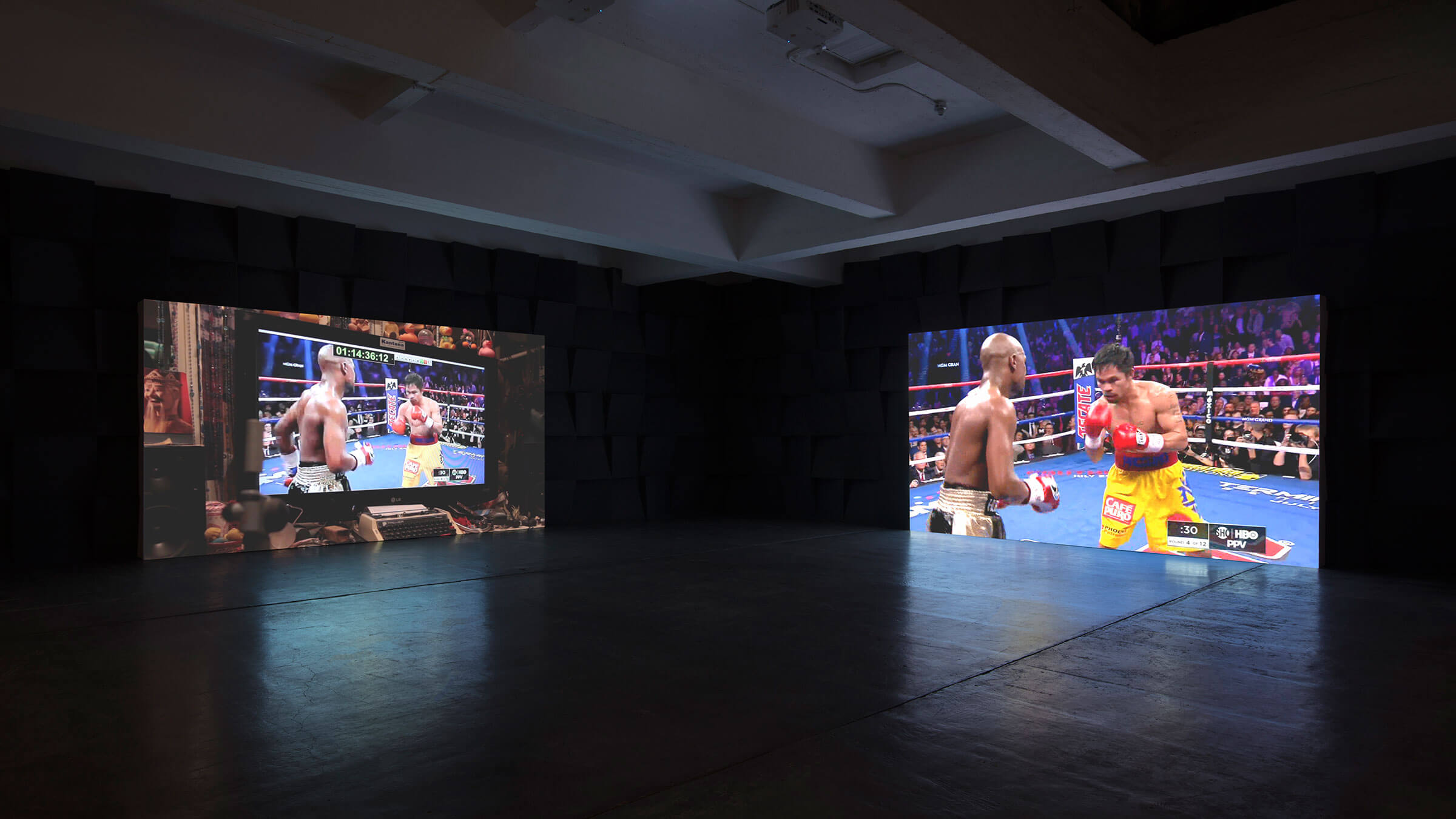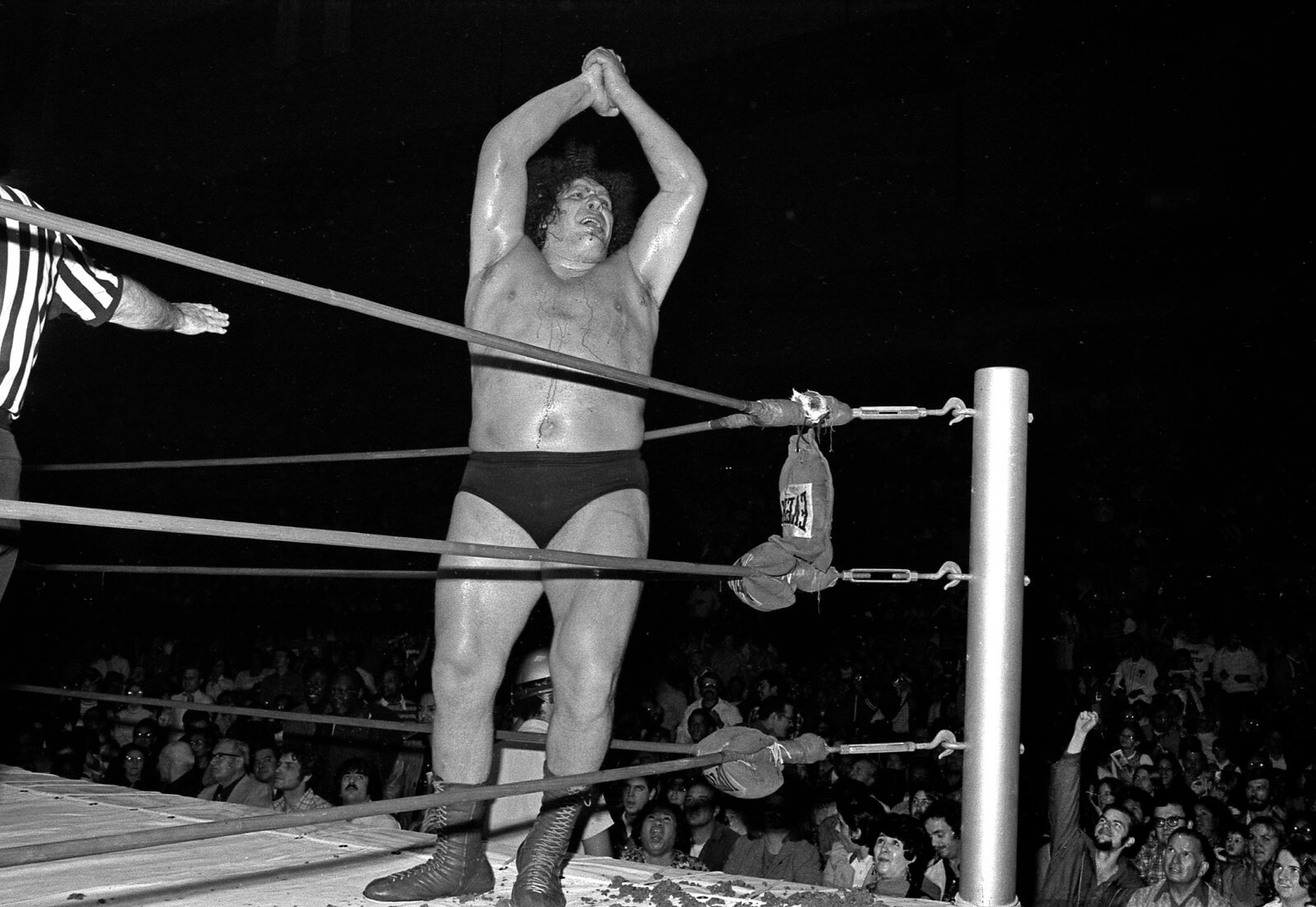Kayfabe
Renaud Proch
February 27, 2017

Two men, wearing little but shorts, somewhere in Chelsea.
Their bodies glisten under the light; it is as though a million pearls of sweat had merged to reflect our million eyes. We watch them, their bodies, their muscles, enmeshed, rushing through time, slowing down time, gaming time. Their breathing gets heavier, their swishing and shuffling louder.
Pause. Rewind. Replay. This is “Three Figures in a Room” (2015-16), a two-channel video work by Paul Pfeiffer, shown at Paula Cooper Gallery in New York last fall and Galerie Perrotin in Hong Kong before that. An excerpt of the 2014 world-event boxing match between Floyd Mayweather and Manny Pacquiao is being reworked, edited, re-mastered, with a focus on its soundtrack: The sound of a step is moved up in time, to match the image sequence; the smack of a hit is enhanced. Rewind. Pfeiffer takes us from the boxing ring of the MGM Grand in Vegas to a Foley studio in Thailand, where sounds are reproduced with odd bits and bobs to be added in post-production.
A dying industry born out of the radio dramas of the last century, Foley studios, and Foley artists working for them, have created sound effects for broadcasting, including movie and television programs, meant to give reality a bump. They use an old chair to produce creaking noises; a celery stalk, a steak, or their own thighs to recreate the sounds of a fistfight. In Pfeiffer’s work, the artists are commissioned to recreate the sounds of the 2014 Mayweather/Pacquiao match-up, which was one of the most anticipated of the last decade. The fight had taken several years of negotiations to arrange—building great expectations for it, leading to a quick sell-out of tickets and large pay-per-view audiences. Yet it was thought to be slow, and heavy on the defense, and was ultimately met with widespread disappointment. The spectacle was deemed unspectacular. To some, it represented the sport’s swan song. Forbes called it “the Death of Boxing.”

In “Three Figures in a Room,” sounds of the fight are enhanced, and the footage is pulled apart into a carefully deconstructed scenario of viewership. The mass-cultural mechanisms of spectacle, especially when built upon sporting events, have long been central to Pfeiffer’s work. Here the artist’s focus is on the ring, on the sounds of the boxers’ footwork, breathing, and their hits, gloves to flesh. The video channels are split between the fight and the studio, while audio playback alternates to keep us, the viewers, guessing and asking what may justify such a laborious effort by the Foley artists.
The goal? Getting somewhere between immersive experience and enhanced reality, a spectrum that has defined the work of Foley artists over the last century. Pfeiffer’s recourse to the art of the Foley gives historical perspective to the kind of amped-up, spectacular version of contemporary reality that is defined by 21st-century mass-media culture.
Pfeiffer’s manipulation of the sound in this footage indeed creates a form of hyperreality. Crafted sounds augment the impact of each hit. They also isolate the action, as only a narrow band of sounds—those in the ring, the steps and the hits—are being recreated. This isolation focuses on the most visceral and violent impact of the footage.
In Pfeiffer’s earlier work the process of isolation was visual. In the series of photographs Four Horsemen of the Apocalypse, for example, the erasure from NBA stock images of all but one figure on the basketball court enhanced the heroic, religious qualities of sports as mass spectacle. Another effect of the artist’s digital sequestration of one from the many was to reveal the background spaces filled with watchful heads in a shared experience of spectacle (now reduced to a single figure)—a sort of communion.
Similarly, only the most central part of the sonic landscape (or what seems to be: the steps, the hits) is recreated in “Three Figures in a Room.” Other surrounding sounds are discarded. This segregating gesture, made for obvious dramatic purposes, also highlights silence in the process. It is the silencing of a million cries from the crowd that becomes the most haunting and violent aural feature of this enhanced fight.
***

Several years ago, a childhood friend introduced me to professional wrestling. We had lost touch for almost a decade, but had found each other again, and she was on her way to New York from Switzerland for a visit. In the years we spent apart, she had developed a keen interest in wrestling, which led her to get a couple of tickets to a WWE fight at the Nassau Veterans Memorial Coliseum. Fascinated by the global reach of wrestling fandom that she embodied, and trusting that she saw in the game something I had missed, I accepted her invitation to join.
Two men, wearing little but shorts, somewhere in Nassau County.
Before the event, my friend gave me a summary of the storylines that would be continued in the action that night. I hadn’t realized that wrestling was such an episodic drama, developed both in the ring and behind the scenes. Beyond the moves and well-rehearsed attacks, the game was an intricate narrative of friendship and betrayal, love and business. While the fights themselves are short, perfectly synchronized to the live TV transmission and its scheduled advertising breaks, the stories never seem to end, or be limited to what is going on in the ring.
My memories of that evening at the Nassau Coliseum are somewhat faded, but the story that unfolded in the ring blended wrestlers, managers, and legal representatives in a battle for control of the franchise: a disgraced former WWE General Manager, who inspired loud disapproval in the audience, delivered his final address, attempting a shuffle of allegiances that was quickly thwarted and transformed into a long and painful string of humiliations.
Interestingly, the focus was not only on the wrestlers, but on the larger wrestling world, one of spectacle and business. “C’est ‘meta’!” my friend whispered to me. “Not unlike the art world,” I remember thinking. With a hint of magic, complex narratives blended truth and fiction. At one point in the evening the fight was interrupted by the sudden, silent appearance of a female wrestler. She was, my friend informed me, the love interest of both wrestlers in the ring. She skipped around the ring once, without saying a word, and promptly disappeared. Her presence upped the fight’s ante, giving a boost of energy to end the fight more swiftly.
Time in the arena is slowed down, then sped up by such appearances, but it is always perfectly coordinated to the needs of advertisers and the broadcasting schedule out of the arena; after all, we were “live” for the needs of a TV audience at home, and were merely acting as an animated backdrop to the fight.
***

What ties these competing realities together, and makes possible a satire that is simultaneously actual and fictional, is what wresting fans call kayfabe.
Kayfabe refers to the consensual, collective suspension of disbelief, my friend explained. It is the conviction with which protagonists and audience alike believe in the events happening in and around the ring, making them true and real, no matter how scripted or staged. It is a fascinating concept. What worth is authenticity, after all, if it holds back the experience of reality? Magic is but a trick unexplained; yet it is awe-inspiring. Foley artists transform velvet gloves into the flapping wings of a dove, but in the process they make us feel as if our ears had touched the bird.
Driven by the will to experience an enhanced reality, Kayfabe codifies this general complicity. It is also a tool for capital gains, in a sports world that is big business. By mining the willingness of the audience to suspend their disbelief, wrestling could develop into a spectacle of violence that delivers thrills without unplanned interruptions, which are bad for business. Spine-shattering moves cause gasps in the audience but no paralyzing injuries among fighters on payroll. Kayfabe has been an essential part of wrestling’s evolution from sport to a soap-opera entertainment industry worth billions; it is the key to turning an unsafe, violent, and therefore unpredictable business into a reliable one, more palatable to broader publics.
In 2011, the online magazine Edge.org asked Eric Weinstein, a mathematician and hedge fund manager, what scientific concept would improve everybody’s cognitive toolkit. For Weinstein, the answer lay in kayfabe. In a short essay, he reflected on kayfabe in the context of a risk-averse contemporary culture, and in a world where deception plays just as much of a role in decision-making as information (from advertising to the complex financial systems that unraveled over the years preceding his essay): “Wrestling discovered the unthinkable: its audience did not seem to require even a thin veneer of realism. Professional wrestling had come full circle to its honest origins by at last moving the responsibility for deception off of the shoulders of the performers and into the willing minds of the audience.”
“Importantly,” he adds, “kayfabe seems to have discovered the limits of how much disbelief the human mind is capable of successfully suspending before fantasy and reality become fully conflated.” Weinstein thought that kayfabe could be a remarkable cognitive tool to sharpen our understanding of the world’s inner workings, a concept that “gives us potentially the most complete example of the general process by which a wide class of important endeavors transition from failed reality to successful fakery.”
Today, in a quest for meaningful, immersive experience of an enhanced reality through art, sports, entertainment, or even politics, it seems the question we are left with is this: What happens when fakery is no longer successful? Does it break the bond of kayfabe? Will this break promote a return to successful reality? Or will it send us to failed reality in frightening ways?